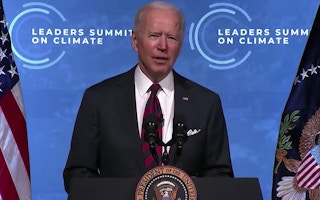The US is back at the climate table, and the Biden-Harris Administration is making climate action a central organising principle of its government.
Already US re-engagement is having an impact across international processes like the G7 and G20. US climate envoy John Kerry has been busy travelling to Europe, the UAE, South Asia and China to rebuild relationships.
Domestically, early signs of action are promising. From US Treasury Secretary Janet Yellen joining the Coalition of Finance Ministers for Climate Action, to Transport Secretary Pete Buttigieg championing resilient infrastructure in the American Jobs Plan.
On the international stage, the big test will be the Leaders’ Summit on Climate taking place virtually on Thursday and Friday (22-23 April).
To succeed, the US must deliver an ambitious domestic climate goal (Nationally Determined Contribution, or NDC) and encourage other countries to enhance their climate ambition. Timed for early in the year, the summit needs to set a high bar if it is to be leveraged throughout 2021.
Setting the stage
Who’s invited? Forty heads of state in total, including the G20 countries and 17 original members of the Major Economies Forum, nations leading on climate, climate-vulnerable countries like Bhutan and the Marshall Islands, and the Europeans who carried the climate diplomacy torch through four years of US absence. Laggards like Brazil and Turkey are also invited to some chagrin. It remains to be seen whether giving them the stage will lead to improved climate policy.
The Leaders’ Summit takes place against a complex geopolitical backdrop. Most countries are still struggling with Covid-19. Recoveries are diverging dangerously, and the climate movement must realise the importance of vaccine rollout as a priority inextricably linked to its own success. Relations between the US, EU and China have deteriorated over a number of issues.
John Kerry has visited China in an effort to persuade President Xi to attend the virtual summit and back China’s climate pledges with action. What does this look like exactly?
The US will ask China to stop burning coal at home and financing coal abroad. China will in turn ask the US to find finance to help developing countries recover from Covid-19 and be able to compete in a warmer, albeit net-zero, world. Beijing has signalled its willingness to reinstate the US–China climate change working group of the Obama era. There is a deal to be done.
With Biden in office, working together with the UK’s G7 and Italy’s G20 presidencies, 2021 also presents a political opportunity to step up on solidarity, as well as make deals with key countries such as India, South Africa and Indonesia to commit to the clean energy transition.
This year has so far shown little evidence of coordination between climate-progressive major powers and climate-vulnerable coalitions, but the summit will offer an opportunity for some trust-building, concerted leadership and joined-up thinking.
The meeting should aim to deliver four things in particular.
More ambition
Current NDCs are vastly insufficient to meet the goals of the Paris Agreement. Ambitious commitments from top emitters will be necessary ahead of COP26 to keep the hope of a 1.5C future alive. Mitigating an additional 9 gigatonnes of emissions – a key benchmark of success this year – hinges on new and improved plans from both China and the US.
A credible US target should aim for at least 50 per cent cuts below 2005 emissions levels by 2030, according to coalitions of American scientists, businesses and NGOs. The White House is reportedly considering a range of emissions cuts between 48-53 per cent. The expectation is that other countries, such as Japan, South Korea, Canada, India, Indonesia and South Africa will also use the summit to announce more ambitious 2030 targets or other climate commitments.
Real economy shifts
A commitment to 100 per cent clean electricity or 0 per cent coal in the next decade will provide evidence that the real economy is shifting to green. The US needs to put real money behind decarbonisation, ending public financing for fossil fuels and supporting green infrastructure, at home and abroad.
Businesses are expected to release a plethora of new climate actions at the summit. If their climate plans are packaged together and released jointly it would denote a clear shift. The summit will also be an opportunity for the US to work with the UK ahead of COP26 in Glasgow later this year on the energy transition, clean road transport and nature-based solutions to climate change.
Climate finance
Developed countries like the US will need to find more money to support developing countries to respond to the pandemic and build back better.
In addition to making good on old climate pledges to the Green Climate Fund, the US must also support major Covid-19 recovery plans, help with debt overhang and public bank reforms such as balance sheet optimisation. One way to do so is through reallocated Special Drawing Rights, a reserve currency issued by the IMF that was last used in the wake of the Great Recession.
There are rumours that a major initiative and injection of private finance for public goods will round out a financial package announced at the summit. In its entirety, the package will have to be at sufficient scale to coax other developed countries to do more and change the politics in the run up to COP26.
Innovation
The summit will need to build confidence that countries can collaborate on research and development, share learnings and still compete in a net-zero global economy. The US will bring to bear its innovative capacity, but solutions will come faster if countries collaborate, along with private sector actors and academia, through platforms like Mission Innovation.
After the past four years, many countries are bruised and sceptical of US leadership, and braced for the pendulum possibly swinging back.
The Leaders’ Summit on Climate is but one moment. By itself, it cannot be enough. Other moments throughout 2021 will have to help build momentum toward COP26 in Glasgow and add to a collective sense that finally – after decades of negotiations – this is the pivotal year.
This article was originally published on China Dialogue under a Creative Commons licence.



















